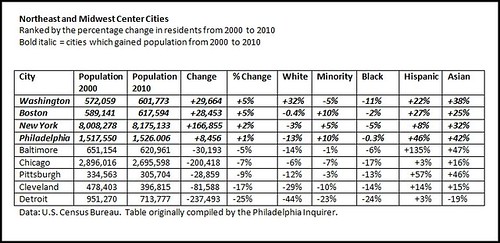More on the 2010 Census and center cities
Reporting in USA Today ("Blacks leaving major cities: More seek suburbs and better weather") and the Philadelphia Inquirer ("Philly or Lake Woebegon? We're slightly above average") on the 2010 Census results in terms of major cities ends up covering more of the story, compared to local reporting in the Washington Post ("D.C.'s black majority status slips away" and "On Barry's old block, a racial shift,") and other local media. From the USA Today article:
The black population is declining in a growing number of major cities — more evidence that the settlement pattern of African Americans is changing as they disperse to suburbia and warmer parts of the nation.
2010 Census data released so far this year show that 20 of the 25 cities that have at least 250,000 people and a 20% black population either lost more blacks or gained fewer in the past decade than during the 1990s. The declines happened in some traditional black strongholds: Chicago, Oakland, Atlanta, Cleveland and St. Louis.
The loss is fueled by three distinct trends:
•Blacks — many in the middle or upper-middle class — leaving cities for the suburbs.
•Blacks leaving Northern cities for thriving centers in the South.
•The aging of the African-American population, whose growth rate has dropped from more than 16% in the 1990s to about 10% since 2000.
All the DC media focused on how with the continued decline of African-American residents, DC, an African-American majority city since the mid-1950s, is now approaching a situation where African-Americans are no longer the majority.
I'm not saying that's not important. It is. But it is only part of the story, which I pointed out in a blog entry last weekend, "Gentrification, neighborhood change, and wacked discourse."
Reporting in the other papers finds that in virtually every major U.S. city covered, African-American population is down compared to the 2000 Census.
-- USA Today webpage on the 2010 Census
-- "Urban centers draw more young, educated adults," USA Today
The Inquirer article had a very nice table showing data of Northeast and Midwest center cities losing and gaining population. It's not available online in a readable fashion, so I copied the data and it is presented below.

Labels: demographics, urban design/placemaking, urban revitalization



0 Comments:
Post a Comment
<< Home